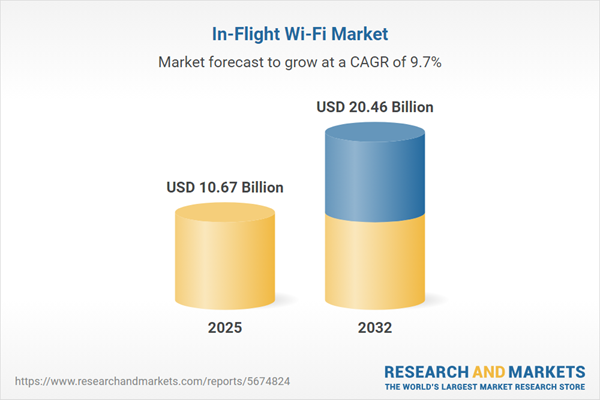Speak directly to the analyst to clarify any post sales queries you may have.
In-flight Wi-Fi is rapidly reshaping airline operations and passenger expectations, presenting new opportunities for leadership and efficiency as digital infrastructure becomes essential across the aviation sector.
Market Snapshot: In-Flight Wi-Fi Market Size and Growth
The global in-flight Wi-Fi market demonstrates robust momentum, with a valuation of USD 9.72 billion in 2024 and an expected rise to USD 10.67 billion in 2025. Exhibiting a compound annual growth rate (CAGR) of 9.74%, the market’s continued expansion is propelled by factors such as increased deployment of connected aircraft technologies, evolving digital business models among airlines, and heightened partnerships with satellite technology firms. As airlines seek optimized operational processes and improved passenger engagement, organizations are adopting new connectivity solutions quickly, expanding service offerings, and addressing evolving regulatory requirements in both domestic and international aviation environments.
Scope & Segmentation: In-Flight Wi-Fi Market Coverage
This report provides actionable guidance to aviation leaders, focusing on the most relevant dimensions influencing investment and transformation in in-flight Wi-Fi implementations. Each area directly impacts connectivity, scalability, and compliance across global airline operations:
- Component: Reviews hardware, software, and value-added services supporting seamless onboard connectivity and enhancing passenger engagement.
- Platform: Examines air-to-ground systems alongside Ka-Band, Ku-Band, and L-Band satellite networks, tailored for specific airline requirements and operational environments.
- Connectivity Technology: Assesses the integration of 4G/5G terrestrial networks and advanced satellite architecture, improving coverage flexibility and network resilience fleet-wide.
- Application: Identifies solutions for passenger entertainment, secure communications, predictive aircraft maintenance, and crew operations, each delivering operational improvements.
- Installation: Contrasts linefit and retrofit methodologies, highlighting the importance of certifications, service consistency, and unified fleet strategies.
- Pricing Model: Considers hybrid, pay-per-use, and subscription models, outlining their impact on airline revenue and evolving passenger preferences.
- End User: Analyzes distinct requirements of commercial airlines, business aviation, and defense aviation, with focus on compliance and technical standards across sectors.
- Regions Covered: Delivers market analysis for the Americas, Europe, Middle East & Africa, and Asia-Pacific, considering the regulatory landscape and investment climate unique to each region.
- Companies Analyzed: Profiles Gogo LLC, Panasonic Avionics, Viasat, Thales S.A., Inmarsat, Honeywell, Intelsat S.A., Hughes Network Systems, SmartSky Networks, and SITAONAIR Limited, detailing their roles and technological contributions within the sector.
Key Takeaways: Strategic Insights for Decision-Makers
- Implementing advanced in-flight Wi-Fi infrastructure results in improved passenger satisfaction and strengthens airline adaptability to changing operational demands.
- Staying aligned with dynamic regulatory and cybersecurity standards compels the adoption of agile processes and a continuous review of technical solutions.
- Collaboration among airlines, equipment providers, and satellite partners drives faster integration of innovative technologies and supports scalable digital platforms across fleets.
- Deploying modular hardware makes it easier for airlines to upgrade and customize connectivity solutions for diverse aircraft types and evolving service needs.
- Aligning service strategies with regional requirements, such as those in the Americas or Asia-Pacific, enables carriers to meet local reliability expectations and regulatory goals effectively.
- Coordinating operational and technology planning enhances returns on connectivity investments while raising consistency across airline networks and fleet operations.
Tariff Impact: Navigating US Trade Measures
Recent US trade tariffs on Wi-Fi hardware are impacting sourcing strategies throughout the sector. To maintain secure supply chains and regional customization, airlines and technology providers are pivoting towards increased domestic manufacturing and modular design adoption. These adaptive responses help sustain operational continuity within a dynamic global trade context.
Methodology & Data Sources
The report utilizes insights from executive-level interviews, comprehensive aviation market studies, and recognized data from sector authorities. Each conclusion is backed by multi-stage peer reviews, ensuring practical value for organizations committed to advancing in-flight Wi-Fi capabilities.
Why This Report Matters for Senior Executives
- Delivers targeted guidance for C-level leaders and technical strategists aiming to reinforce partnerships, drive innovation, and inform connectivity investment roadmaps.
- Supports critical benchmarking and strategic alignment for companies seeking to match or exceed digital transformation progress set by leading airlines and service providers.
- Equips stakeholders to proactively address regulatory shifts and technological advances, building long-term organizational resilience as market requirements evolve.
Conclusion
This report empowers decision-makers to confidently plan and execute effective fleet upgrades, ensuring organizational relevance and resilience in the ever-evolving landscape of in-flight connectivity and airline digital transformation.
Additional Product Information:
- Purchase of this report includes 1 year online access with quarterly updates.
- This report can be updated on request. Please contact our Customer Experience team using the Ask a Question widget on our website.
Table of Contents
3. Executive Summary
4. Market Overview
7. Cumulative Impact of Artificial Intelligence 2025
Companies Mentioned
The companies profiled in this In-Flight Wi-Fi market report include:- Gogo LLC
- Panasonic Avionics Corporation
- Viasat, Inc.
- Thales S.A.
- Inmarsat plc
- Honeywell International Inc.
- Intelsat S.A.
- Hughes Network Systems, LLC
- SmartSky Networks, LLC
- SITAONAIR Limited
Table Information
| Report Attribute | Details |
|---|---|
| No. of Pages | 181 |
| Published | October 2025 |
| Forecast Period | 2025 - 2032 |
| Estimated Market Value ( USD | $ 10.67 Billion |
| Forecasted Market Value ( USD | $ 20.46 Billion |
| Compound Annual Growth Rate | 9.7% |
| Regions Covered | Global |
| No. of Companies Mentioned | 11 |









